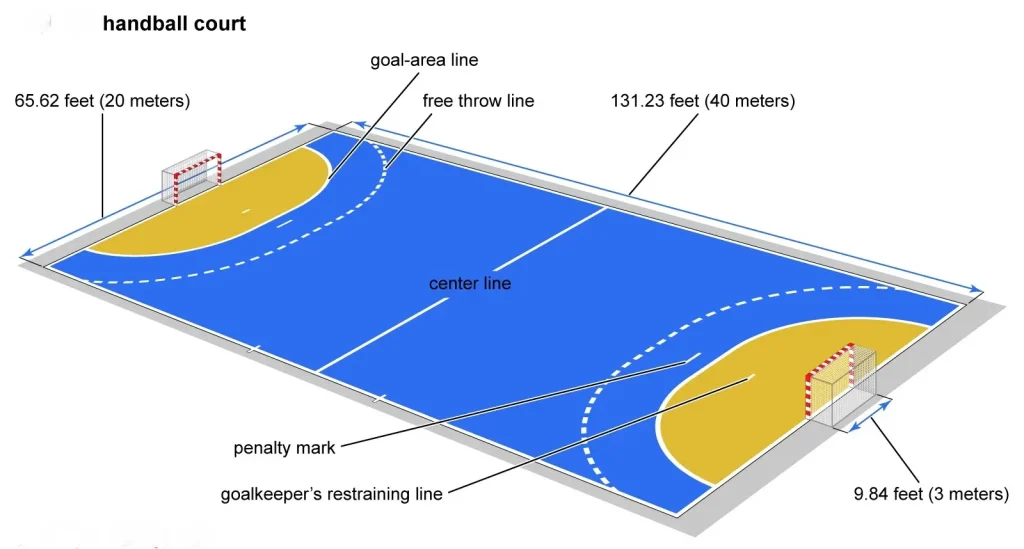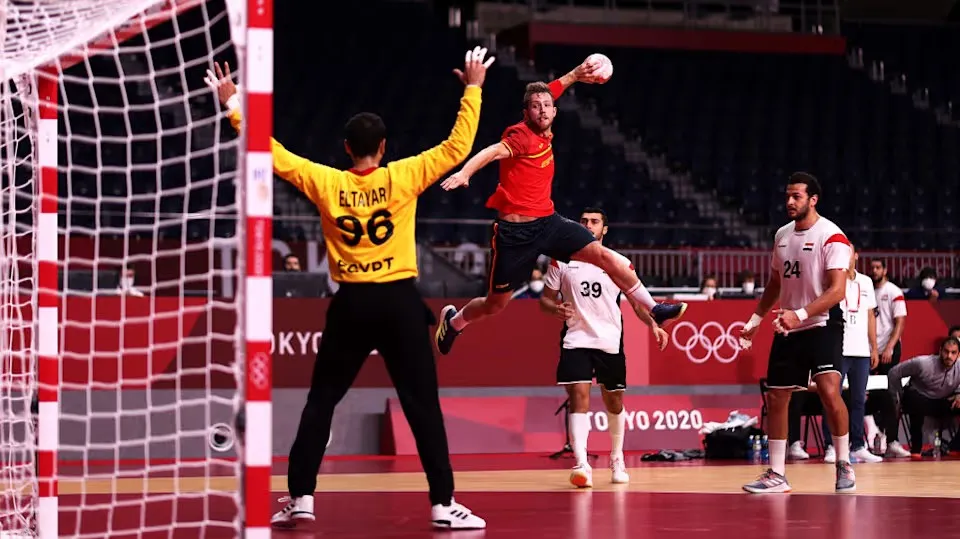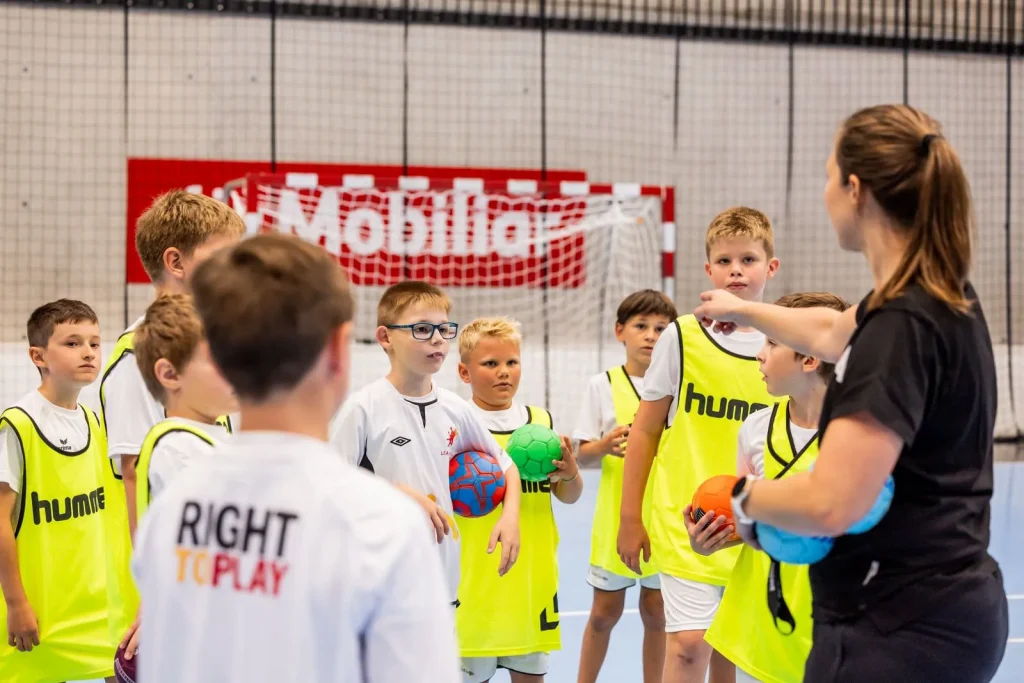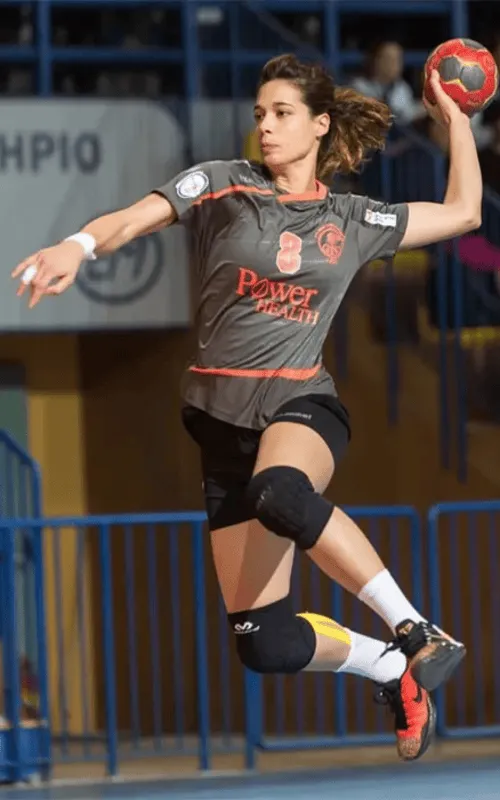Imagine a game where you get to run, jump, pass, and throw — all while working together with a team to score lots of goals. That’s exactly what team handball is, a super exciting sport that many people around the world love to play. Here’s a kid-friendly guide to what handball is, how it’s played, and why it’s so much fun!
The Big Picture: What Is Handball?
Handball (sometimes called “European handball” or “indoor handball”) is a team sport. Two teams face off, each with seven players: six who move all around the court, and one goalie.
The goal? Score more times than the other team by throwing a small ball into your opponent’s net.
A standard game has two halves, each 30 minutes long, and is usually played indoors on a special court measuring 40 metres by 20 metres.

Where Did Handball Come From?
Handball as we know it today started in the early 20th century. But the idea of hitting a ball with your hand goes way back — even to ancient Rome! Over the years, the game evolved and modern rules were introduced, making it very fast, fun, and dynamic.

How Do You Play Handball?
Here are some of the main rules and ideas in handball:
- Players can run with the ball, but only for up to three steps before passing or bouncing (dribbling) it.
- You can pass the ball to teammates, hold it, or take a shot at the goal.
- The area closest to the goal is called the goal area, and only the goalkeeper may remain on the court within that zone.
- When you score a goal, it must be thrown from outside that zone unless you’re “diving in” while shooting.
- The ball is specially made: it’s designed to account for hand size, age, and gender.

What Makes Handball So Exciting?
- Speed: Handball is very fast! Players sprint, pass, and shoot quickly.
- Teamwork: You really need to work with your teammates. Passing, running, and playing together all matter.
- Powerful Shots: Shots can be thrown very fast — in some cases, players throw at speeds close to 100 km/h!
- Skill Variety: The goalie needs to be quick and brave. The attackers need to dribble, pass, and aim well.
- High Scoring: Since goals are relatively easy to get (compared to some other sports), scores are often pretty high, which makes games fun to watch and play.
Variations of Handball
Handball isn’t just one thing — there are a few different versions you might see:
- Indoor (Team) Handball: The most common kind — like what we’ve been describing, with seven players per team on a hard-court.
- Beach Handball: Played on sand with fewer players (usually four per side). Shots can be extra cool and are sometimes worth more if done in a “spectacular” way!
- Wall Handball (or Court Handball): This is a very different kind — you hit a ball against a wall, kind of like “squash with your hand.”

Handball in the Special Olympics
Handball is also a big deal in the Special Olympics, which makes it very inclusive, allowing people of different abilities to play.
Some of the features in Special Olympics handball:
- Played on a 40 × 20 metre court, just like the regular version.
- Teams are made up of seven players: six outfield players and one goalkeeper.
- They sometimes use a softer or foam ball, especially for younger or less experienced players.
- Rules are adapted to make the game safer and more fun, while still being physically active and competitive.

Why Play Handball?
Here are a few great reasons why handball is a really good sport for kids (and adults!):
- Fitness: It’s excellent exercise — running, jumping, and throwing all help you stay healthy.
- Team Spirit: You learn how to cooperate, pass, and support others.
- Quick Thinking: Because the game is fast, you’ve got to make decisions quickly: pass, run, shoot?
- Inclusiveness: With adaptations (like in the Special Olympics), many people can enjoy it.
- Fun: Scoring is frequent, so there’s lots of excitement and cheering.
What Do You Need to Play?
To get started with handball, you don’t need a huge amount:
- A handball (the ball is small enough to hold comfortably in one hand)
- A court with a goal at each end (for indoor handball)
- Teammates — handball is all about working together
- A coach or someone who knows the rules to help you learn
Famous Facts & Fun Trivia
- Handball is played by millions of people worldwide, and there are national and international competitions.
- It’s even part of the Summer Olympics!
- The International Handball Federation (IHF) is the main group that oversees handball around the world.
- There’s a rulebook from the Special Olympics so that everyone can play safely and fairly.
How Kids Can Get Involved
If you’re 7–14 and want to try handball, here are some simple steps:
- Ask at your school: Some schools or after-school clubs might already offer handball.
- Join a local club: Handball clubs are a great way to train and have fun with other kids.
- Try “mini-handball”: Some places use smaller balls, smaller teams, and simpler rules so younger children can play safely.
- Watch a game: Seeing handball live or on video can help you understand how players move, pass, and score.
Final Thoughts
Handball is a super-cool sport: fast, fun, and full of teamwork. Whether you want to sprint down the court, make a clever pass, or leap in the air to score a goal, there’s something for everyone. Plus, because it’s played in so many countries and by people of different ages and abilities (like in the Special Olympics), handball is a sport that brings people together.
So, if you’ve never tried handball before — why not give it a go? You might discover a new favourite game!
For more interesting articles, please visit www.kidzherald.com




